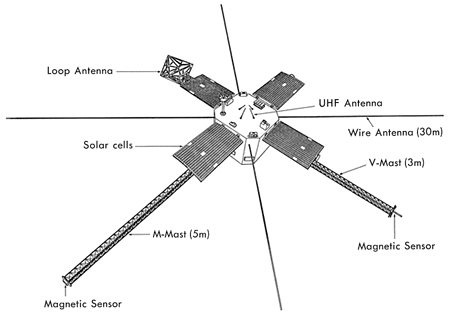"AKEBONO" Operation Completed
April 23, 2015 (JST)
Japan Aerospace Exploration Agency (JAXA)
The Japan Aerospace Exploration Agency (JAXA) stopped sending and receiving radio waves to and from the Aurora Observation Satellite “AKEBONO” (EXOS-D) at 15:59 p.m. on April 23, 2015 to terminate its operation.

The AKEBONO was Japan's third aurora observation satellite launched by the M-3SII Launch Vehicle on February 22, 1989, from the Uchinoura Space Center, which belonged to the then Institute of Space and Astronautical Science, Ministry of Education, Science and Culture.
The AKEBONO continued its observation activities for 26 years and two months, amazingly longer than its target life of one year, and attained various important achievements by observing not only aurora phenomena in the polar region of the Earth but also the long-term periodical changes of the Van Allen radiation belt (a radiation layer surrounding the Earth like a donut that consists of electrons and protons being held by the Earth's magnetic field.) Unfortunately many of the onboard observation instruments had stopped their operation due to deterioration by radiation, and the satellite was also not able to acquire enough observation data for scientific achievements lately because of degradation of its onboard electric system and lowered flight altitude. Therefore, JAXA decided to terminate it operation.
We would like to express our profound appreciation to all relevant personnel and organizations who have helped and supported us in our operations.
Message from AKEBONO Project Manager, Associate Professor Ayako Matsuoka
Thank you very much for all of you who have supported the AKEBONO observation operations for such a long time. I would also like to renew and send my highest respects to my predecessor and former AKEBONO team members who sent the satellite into its orbit 26 years ago. We will keep generating new achievements by utilizing data acquired by the AKEBONO.
Reference 1: Major achievements of the AKEBONO
For major AKEBONO achievements, please refer to the following URLs for reports for th Space Activities Commission as well as for the Space development and utilization committee, and the AKEBONO project website.
March 25, 2009
- Space Activities Commission (Japanese language only)
April 9, 2015
Reference 2: Overview of AKEBONO
| Launch | At 8:30 a.m. on February 22, 1989 (Japan Standard Time) | |
|---|---|---|
| Structure | Mass | About 295 kg |
| Configuration | 100 cm high, 126 cm long from face to face
Octagonal cylinder with four solar-array paddles
Equipped with 30 m-long antenna and two (5 m and 3 m) extendable masts
|
|
| Orbit | Altitude | Perigee: 270 km Apogee: 10,500 km |
| Inclination | 75 degrees | |
| Type | Highly elliptical orbit | |
| Period | About 211 minutes | |
| Major mission instruments | Three-axis fluxgate magnetometer (MGF) Electric field detector (EFD) VLF wave detector (VLF) HF wave detector and topside sounder (PWS) Low energy ion detector (LEP) Suprathermal ion spectrometer (SMS) Thermal electron detector (TED) Radiation detection monitor (RDM) Visible and UV auroral imager (ATV) |
|